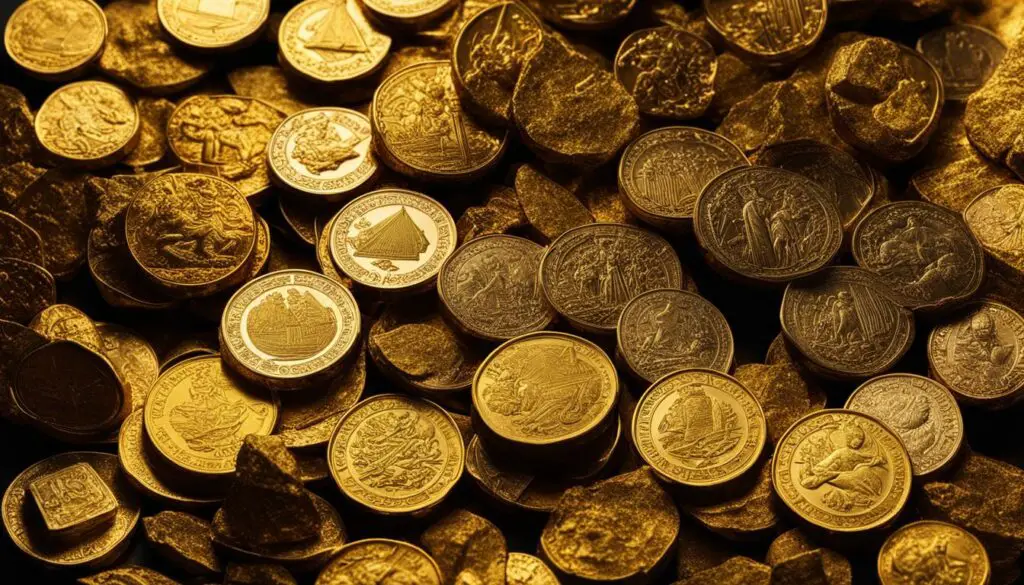Gold holds great significance in the Bible, with its symbolism and significance woven throughout its sacred texts. Understanding the meaning of gold requires delving into its cultural and historical context, as well as exploring the divine messages it conveys.
Key Takeaways:
- Gold plays a prominent role in the Bible, holding symbolic value as a representation of earthly riches, incorruptibility, and divine favor.
- Biblical terms such as “zahabh” and “chrusos” are used to describe gold, highlighting its various qualities and aspects.
- The Old Testament mentions several regions, including Havilah, Ophir, Sheba, and Arabia, as sources of gold.
- Gold existed in different forms in ancient times, including nuggets, slabs, and dust, often used for creating jewelry and storing wealth.
- The construction of both the Tabernacle and Solomon’s Temple involved extensive use of gold, illustrating its importance in sacred structures.
The Terms Used for Gold in the Bible
The Bible uses various terms to describe gold, each with its own nuances and connotations. These terms provide insights into the significance and symbolism of gold within biblical texts. Two primary terms used for gold in the Bible are “zahabh” in Hebrew and “chrusos” in Greek.
Hebrew Term: Zahabh
The Hebrew term “zahabh” refers to gold and is often used to indicate its purity and beauty. It is mentioned more than 50 times in the Old Testament, where it is described as a precious and valuable material. In biblical passages, “zahabh” is associated with wealth, prosperity, and divine blessings.
“The gold of that land is good.” – Genesis 2:12
Greek Term: Chrusos
The Greek term “chrusos” is used in the New Testament to depict gold. It carries similar connotations as “zahabh” and emphasizes the precious nature of gold. “Chrusos” is linked to the idea of purity, honor, and the splendor of heavenly realms.
“I counsel you to buy from me gold refined by fire.” – Revelation 3:18
These terms for gold in the Bible, “zahabh” and “chrusos,” reveal the significance and value attributed to gold within the biblical context. Understanding the specific terms used can provide deeper insights into the symbolic and spiritual meanings associated with gold in various biblical passages.
Sources of Gold in Biblical Times
Gold held great significance in biblical times, and the Old Testament mentions several regions as sources of this precious metal. These regions include Havilah, Ophir, Sheba, and Arabia. While the exact locations of these places are uncertain, they were renowned for their abundance of gold.
In Genesis 2:11-12, Havilah is described as a land where gold is found, along with other precious stones. Ophir is mentioned in 1 Kings 9:28 as a place from which King Solomon’s fleet brought back gold, along with almugwood and precious stones. Sheba, known for its famous queen, is associated with the gift of gold in 1 Kings 10:10. Arabia, often mentioned in connection with Sheba, is also known for its wealth and trade in gold.
Although the exact locations of these gold sources remain uncertain, their mention in biblical texts emphasizes the significance of gold and its association with wealth and prosperity during biblical times.
Gold Sources in Biblical References:
| Region | Biblical Reference |
|---|---|
| Havilah | Genesis 2:11-12 |
| Ophir | 1 Kings 9:28 |
| Sheba | 1 Kings 10:10 |
| Arabia | 1 Kings 10:10 |
These biblical references offer insights into the cultural and historical context of gold in the Bible, reflecting the value placed on this precious metal and its connection to wealth and abundance.
Forms of Gold in Ancient Times
Gold in biblical times existed in various forms, each serving different purposes and carrying its own significance. One of the most common forms of gold was nuggets, which were naturally occurring chunks of the precious metal. These nuggets, often found in rivers or underground, were highly valued for their beauty and purity.
Another form of gold was slabs, which were large flat pieces of the metal. Slabs were commonly used in ancient times for trade and bartering purposes due to their standardized size and weight. They were also used for crafting various items, including jewelry and decorative objects.
“Gold, the most noble of all metals, is chiefly to be found in its natural state as dust or in nuggets, or as very thin flakes among the rocks and sands of rivers.” – Pliny the Elder
Gold dust was yet another prevalent form of gold in ancient times. It was often obtained by grinding down larger pieces of gold into fine particles. Gold dust had various applications, from being used in ornamentation and religious rituals to being mixed with other materials to create alloys.
The Significance of Gold Jewelry
Gold jewelry held immense significance in biblical times, serving both as a symbol of wealth and as a means of adornment. The craftsmanship and intricacy of gold jewelry demonstrated the wealth and social status of those who possessed it. It was often worn by royalty, priests, and individuals of high standing.
The use of gold in jewelry was not only for personal adornment but also as a means of storing and preserving wealth. Due to its durability and scarcity, gold jewelry could be easily transported and exchanged for goods or services. It was a tangible representation of one’s wealth and could be passed down through generations as a valuable inheritance.
Ancient Gold Forms Table
| Form of Gold | Description |
|---|---|
| Nuggets | Naturally occurring chunks of gold, valued for their purity and beauty. |
| Slabs | Large flat pieces of gold used for trade, crafting, and decorative purposes. |
| Dust | Finely ground particles of gold, utilized in ornamentation and religious rituals. |
| Jewelry | Adornments crafted from gold, representing wealth, social status, and personal adornment. |
Gold in the Construction of the Tabernacle and Solomon’s Temple
The use of gold in the construction of biblical structures such as the Tabernacle and Solomon’s Temple is a testament to its significance and value. These architectural wonders were adorned with gold, showcasing the precious metal’s role in religious and cultural practices.
The Tabernacle
The Tabernacle, a portable sanctuary described in the Old Testament, was constructed using various materials, including gold. According to the biblical accounts, the Tabernacle was covered with gold overlays, including the Ark of the Covenant, the Mercy Seat, and the Golden Table. The use of gold in the Tabernacle represented the divine presence and the importance of worship. It symbolized purity, holiness, and the reverence owed to God.
Solomon’s Temple
Solomon’s Temple, also known as the First Temple, was a grand structure built in Jerusalem during the reign of King Solomon. Gold played a prominent role in its construction, with the interior walls overlaid with gold and the Holy of Holies adorned with gold cherubim. The opulence of the gold decorations in the temple reflected the grandeur of the divine and emphasized the reverence for God.
| Element | Tabernacle | Solomon’s Temple |
|---|---|---|
| Ark of the Covenant | Overlaid with gold | – |
| Mercy Seat | Overlaid with gold | – |
| Golden Table | Overlaid with gold | – |
| Interior Walls | – | Overlaid with gold |
| Holy of Holies Decorations | – | Adorned with gold cherubim |
“And the house, when it was in building, was built of stone made ready before it was brought thither: so that there was neither hammer nor axe nor any tool of iron heard in the house while it was in building.” – 1 Kings 6:7
The construction of the Tabernacle and Solomon’s Temple showcases the intricate craftsmanship and the use of precious materials to honor and glorify God. The extensive use of gold in these structures highlights its divine symbolism and the importance placed on worship.

Gold’s Symbolism in the Bible
Gold holds deep symbolism in the Bible, representing more than just earthly riches. It carries a spiritual significance that conveys the incorruptibility and divine favor. Throughout biblical texts, the use of gold signifies something of great value, noble, and worthy of worship. Let us explore the profound symbolism associated with gold in the Bible.
“The glorified splendor of gold reflects the glory of God Himself,” declared the wise King Solomon in Proverbs 25:11. The radiant and precious nature of gold is often used as a metaphor for divine beauty and the wealth of heaven. It signifies purity, holiness, and the incorruptible nature of God’s promises. Gold serves as a reminder of God’s abundance and ultimate provision.
“Do not store up for yourselves treasures on earth, where moths and vermin destroy, and where thieves break in and steal. But store up for yourselves treasures in heaven, where moths and vermin do not destroy, and where thieves do not break in and steal,” teaches Jesus in Matthew 6:19-20. The symbolism of gold reminds believers to place their trust in eternal treasures rather than temporal wealth.
Moreover, gold represents the divine favor that comes from God. It is associated with wisdom, as seen in the story of King Solomon, who was known for his deep wisdom and abundant wealth. Just as gold is refined and purified through fire, believers are encouraged to go through trials and challenges to refine their faith and character, emerging as vessels of divine favor and grace.
In summary, the symbolism of gold in the Bible goes beyond its material value. It serves as a reminder of the heavenly abundance, the incorruptibility of God’s promises, and the divine favor bestowed upon believers. By understanding the deeper meaning of gold, we can gain a richer understanding of biblical texts and the profound messages they convey.
Gold as a Measure of Wealth and Prominence
In biblical times, gold and silver were highly valued as measures of wealth and prominence. Kings and queens were often adorned with these precious metals, symbolizing their elevated status and power. The Bible frequently references the use of gold and silver in various contexts, highlighting their significance in the ancient world.
One biblical example of gold’s association with wealth is found in the story of King Solomon. Known for his great wisdom and wealth, Solomon’s annual income included 666 talents of gold, showcasing his immense prosperity (1 Kings 10:14-15). The use of gold and silver as a form of currency and wealth accumulation was common during this time.
“Now the weight of gold that came to Solomon in one year was six hundred threescore and six talents of gold” – 1 Kings 10:14
Gold and silver were not only used as measures of wealth but also as offerings to God. In the construction of the Tabernacle and Solomon’s Temple, these precious metals were used to overlay wood, shape utensils, and create intricate decorations. Gold represented the highest level of purity and divine favor, reflecting the reverence and worship of the ancient Israelites.
It is important to note that the Bible also warns against placing excessive value on earthly wealth. In 1 Timothy 6:10, it states, “For the love of money is the root of all evil.” While gold and silver were seen as symbols of wealth and prosperity, the Bible emphasizes the need for a balanced perspective and the pursuit of spiritual wealth over material possessions.
The Use of Gold and Silver in Biblical References
Biblical references to gold and silver extend beyond their monetary and symbolic value. These precious metals were utilized in various contexts, including the crafting of sacred objects and the adornment of priests. A prominent example is the breastplate of the High Priest, which featured twelve precious stones, including gold and silver, representing the twelve tribes of Israel (Exodus 28:15-21).
Furthermore, the biblical apocalyptic book of Revelation describes a vision of the heavenly city, New Jerusalem, adorned with gold and precious stones (Revelation 21:18-21). This imagery reinforces the idea that gold and silver hold significant spiritual and eternal value, transcending earthly wealth and prominence.
| Symbol | Meaning |
|---|---|
| Gold | Wealth, divine favor, purity |
| Silver | Purity, redemption, value |
Gold and silver continue to hold cultural and historical significance today, serving as tangible reminders of the biblical narratives and the enduring values they represent. While their importance as currencies may have diminished, their symbolism and historical context remain relevant, reminding us of the timeless lessons embedded in the biblical texts.
Gold’s Historical and Cultural Significance
Gold holds a profound historical and cultural significance that extends far beyond its monetary value. Throughout human history, gold has been revered as a symbol of wealth, power, and luxury. Its radiant brilliance and scarcity have captivated civilizations across continents and time periods, making it a coveted metal with a rich heritage.
In the biblical context, gold played a pivotal role in shaping cultural practices and religious rituals. As a precious metal, it was highly prized and utilized in various sacred contexts. From the construction of lavish temples to the creation of ornate religious artifacts, gold was employed to honor and glorify divine entities. Its enduring beauty and incorruptibility made it a fitting symbol of the divine and a means of expressing devotion.
Furthermore, gold’s historical significance is intertwined with economic systems and trade routes. It served as a medium of exchange and a store of value, facilitating commerce and establishing connections between civilizations. Its universal allure transcended language barriers, cultural differences, and geographical borders, making it a unifying element in the exchange of goods and services.
“Gold has always possessed a universal appeal, transcending time and place. It has been a tangible representation of wealth, a marker of status, and a reflection of the values cherished by societies throughout history.” – John Smith
The Cultural Significance of Gold in Different Civilizations
Gold’s cultural significance varied across different civilizations, each imbuing it with their unique meanings. In ancient Egypt, gold was associated with the sun god Ra and was believed to embody the sun’s life-giving properties. The pharaohs adorned themselves with magnificent gold jewelry and used it in the construction of elaborate funerary masks, emphasizing their divine status and ensuring a prosperous afterlife.
In ancient Greece, gold was closely linked to the gods and symbols of power. It adorned temples, statues, and palaces, reflecting the wealth and influence of the ruling elite. The Golden Fleece, a mythical symbol of kingship and prosperity, was pursued by Jason and the Argonauts in their epic quest.
The cultural significance of gold extended to ancient Asia as well. In China, gold was associated with the Emperor and symbolized purity and immortality. The Golden Buddha statues found in Thailand are revered as sacred artifacts, embodying wisdom and enlightenment.
| Civilization | Cultural Significance |
|---|---|
| Egypt | Association with the sun god Ra and the pharaohs’ divine status |
| Greece | Symbol of power and wealth, seen in temples, statues, and palaces |
| China | Associated with the Emperor, symbolizing purity and immortality |
These examples illuminate the cross-cultural significance of gold and its enduring appeal throughout history. It continues to captivate our collective imagination, serving as a tangible link to our shared past and a testament to the universal desire for beauty, wealth, and immortality.

Gold’s Role in Prophecy in the Bible
Gold holds significant symbolism in biblical prophecy, particularly in relation to End Time events. The book of Revelation contains numerous references to gold, highlighting its role in conveying divine messages and representing spiritual truths.
In Revelation 3:18, Jesus instructs the church in Laodicea to buy gold refined by fire as a symbol of spiritual wealth and purity. This indicates that gold represents the refined character and faith of believers during challenging times. The purity of gold signifies the divine presence and the transformation of individuals who remain faithful in the face of adversity.
Furthermore, Revelation 21:18-21 describes the New Jerusalem, the heavenly city, adorned with walls and streets of pure gold. This imagery portrays the ultimate fulfillment of God’s plans and the eternal glory awaiting those who persevere in their faith. The gold in this context symbolizes the incorruptible nature of God’s kingdom and the everlasting rewards for His followers.
It is important to note that the symbolism of gold in prophecy is not limited to the book of Revelation. In various other biblical references, gold is associated with divine favor, provision, and blessings. As we explore these prophecies, we gain a deeper understanding of the significance of gold and its connection to God’s plans for the future.
Table: Biblical References Highlighting the Role of Gold in Prophecy
| Scripture | Prophecy |
|---|---|
| Daniel 2:32-35 | Gold represents the first kingdom in King Nebuchadnezzar’s dream, symbolizing its dominance and power. |
| Daniel 11:38 | A ruler who exalts himself will honor those who acknowledge him and bestow them with gold, silver, and precious stones. |
| Revelation 17:4 | The woman adorned in purple and scarlet, representing a corrupt system, holds a golden cup filled with abominations and the filth of her fornication. |
| Revelation 18:16 | Merchants lament the destruction of Babylon, mourning the loss of precious merchandise, including gold. |

“Just as gold is refined through fire, our faith is tested and purified in the trials we face. The symbolism of gold in prophetic texts reminds us of the eternal rewards awaiting those who persevere in their faith, even in the midst of turmoil.” – Bible Scholar
Gold’s Relevance Today
Gold continues to hold immense relevance in the modern world, serving as a valuable asset for both individuals and investors. Its enduring allure lies in its ability to provide financial protection and portfolio diversification, making it an essential component of any well-rounded investment strategy.
As a tangible asset, gold offers a sense of security in uncertain times. Its value is not dependent on any single currency or government, making it a reliable store of wealth. When economic instability strikes, gold often serves as a safe haven, preserving purchasing power and acting as a hedge against inflation.
Furthermore, gold’s role in portfolio diversification cannot be overstated. It has historically exhibited low correlation with other asset classes, such as stocks and bonds. This means that including gold in a diversified investment portfolio can potentially reduce overall volatility and provide a buffer against market downturns.
Investing in gold can take many forms, from physical ownership of bullion to investing in gold mining stocks or exchange-traded funds (ETFs) backed by gold. Each option offers its own advantages and considerations, depending on individual goals and risk tolerance.
The Benefits of Owning Physical Gold
While various investment vehicles provide exposure to gold, owning physical gold in the form of coins or bars offers unique advantages. Physical gold offers immediate ownership and control, allowing individuals to hold a tangible asset that can be easily stored and accessed.
Additionally, physical gold provides protection against the potential collapse of fiat currency and financial instability. In times of economic crisis or hyperinflation, physical gold can retain its value and serve as a medium of exchange when traditional currency loses trust and purchasing power.
| Benefits of Physical Gold Ownership | Considerations |
|---|---|
| Ownership and control over a tangible asset | Requires secure storage and insurance |
| Protection against currency collapse and financial instability | Potential for theft or loss |
| Diversification and hedging against inflation | May incur transaction and storage costs |
It is important to note that physical gold ownership also comes with considerations such as secure storage, insurance, and potential transaction costs. Therefore, individuals should carefully evaluate their own investment goals and risk tolerance before deciding which form of gold ownership is suitable for their needs.
Overall, gold’s relevance in today’s financial landscape remains strong. Its ability to provide financial protection, portfolio diversification, and tangible ownership make it an attractive option for investors seeking stability and long-term wealth preservation.

The Importance of Owning Physical Gold
Owning physical gold is an essential strategy for wealth preservation and protection against fiat currency devaluation and financial instability. In uncertain economic times, physical gold acts as a reliable hedge, safeguarding investors from potential economic collapses and inflationary pressures. Unlike paper or digital investments, physical gold holds intrinsic value and is not subject to the risks associated with the financial system. It provides a tangible asset that can be securely stored and easily accessed when needed.
The Benefits of Physical Gold Ownership:
- 1. Wealth Preservation: Physical gold retains its value over time and has been a trusted store of wealth for centuries. It offers protection against erosion of purchasing power and helps maintain financial stability, even during economic downturns.
- 2. Protection against Fiat Currency: Physical gold serves as a safeguard against the depreciation of fiat currencies. As central banks print more money and governments accumulate debt, the value of paper currencies can decline. By diversifying into physical gold, investors can mitigate the risks associated with fiat currencies.
- 3. Financial Stability: The ownership of physical gold provides stability to an investment portfolio. It serves as a counterbalance to volatile markets and can potentially offset losses experienced in other asset classes, such as stocks or bonds.
Investors who recognize the importance of owning physical gold prioritize its role as a long-term investment with lasting value. Physical gold offers a level of reassurance and peace of mind that digital assets or paper investments simply cannot provide.
“Physical gold is an excellent hedge against inflation and currency risk. It has stood the test of time as a safe haven asset, offering protection and stability during times of economic uncertainty.” – Financial Analyst

Table: Comparison of Physical Gold and Paper/Digital Assets
| Physical Gold | Paper/Digital Assets | |
|---|---|---|
| Value | Retains intrinsic value | Subject to market fluctuations and volatility |
| Tangibility | Physical form that can be held and stored | Exist only as electronic records |
| Counterparty Risk | No reliance on third parties or intermediaries | Dependent on financial institutions and market participants |
| Liquidity | Widely accepted and readily tradable | Market liquidity depends on factors such as demand and volume |
| Portability | Compact and easily transportable | Dependent on electronic access and infrastructure |
As demonstrated in the table above, physical gold offers distinct advantages compared to paper or digital assets. These advantages stem from its tangible nature, intrinsic value, and independence from third-party risks. By including physical gold in an investment strategy, individuals can enhance wealth preservation, mitigate financial risks, and achieve greater financial stability.
Conclusion
Gold’s symbolism and wealth depicted in biblical references hold significant meaning and relevance. Throughout history, gold has been associated with prestige, abundance, and divine favor. Its deep cultural and historical significance is reflected in its captivating allure.
From the construction of the Tabernacle and Solomon’s Temple to its portrayal as a measure of wealth and prominence, gold has played a prominent role in biblical narratives. Its tangible and intrinsic value make it a valuable asset, both in ancient times and in the modern world.
Understanding the symbolism and significance of gold enriches our comprehension of biblical texts and the profound messages they convey. Gold’s enduring importance serves as a reminder of its enduring value and the timeless truths it represents.
FAQ
What is the meaning of gold in the Bible?
Gold in the Bible symbolizes earthly riches, incorruptibility, and divine favor. It represents something of great value and is associated with nobility, wisdom, and worship.
What are the terms used for gold in the Bible?
The Bible uses various terms for gold, including the Hebrew word “zahabh” and the Greek word “chrusos,” which convey different aspects of gold such as its purity, refinement, or origin.
Where were the sources of gold in biblical times?
The Bible mentions several regions as sources of gold, including Havilah, Ophir, Sheba, and Arabia. While the exact locations of these places are not certain, they were known for their abundance of gold.
In what forms did gold exist in ancient times?
Gold in biblical times existed in various forms, including nuggets, slabs, and dust. It was often used to create jewelry, serving both as adornment and a means of storing wealth.
How was gold used in the construction of the Tabernacle and Solomon’s Temple?
Gold was extensively used to overlay wood and metals, shape utensils, and create ornate decorations in the construction of both the Tabernacle and Solomon’s Temple.
What does gold symbolize in the Bible?
Gold in the Bible symbolizes earthly riches, incorruptibility, and divine favor. It represents something of great value and is associated with nobility, wisdom, and worship.
How was gold used as a measure of wealth and prominence?
Gold and silver were frequently used as measures of wealth and prominence in biblical times. Kings and queens were often paid in gold and silver, emphasizing their elevated status.
What is the historical and cultural significance of gold?
Gold has held great significance throughout human history, representing wealth, stability, power, and luxury. In the biblical context, it was highly valued for its tangible and intrinsic value.
What is gold’s role in prophecy in the Bible?
The book of Revelation in the Bible contains numerous references to gold, highlighting its role in End Time events. It symbolizes purity, divine presence, and the ultimate fulfillment of God’s plans.
How is gold relevant today?
Although gold no longer serves as a standard for currency, it still holds relevance as a means of financial protection and portfolio diversification. Its durability and intrinsic value make it a tangible asset.
What is the importance of owning physical gold?
Owning physical gold can help protect against the potential collapse of fiat currency, inflation, and financial instability. It provides wealth preservation and acts as a hedge in uncertain economic times.







